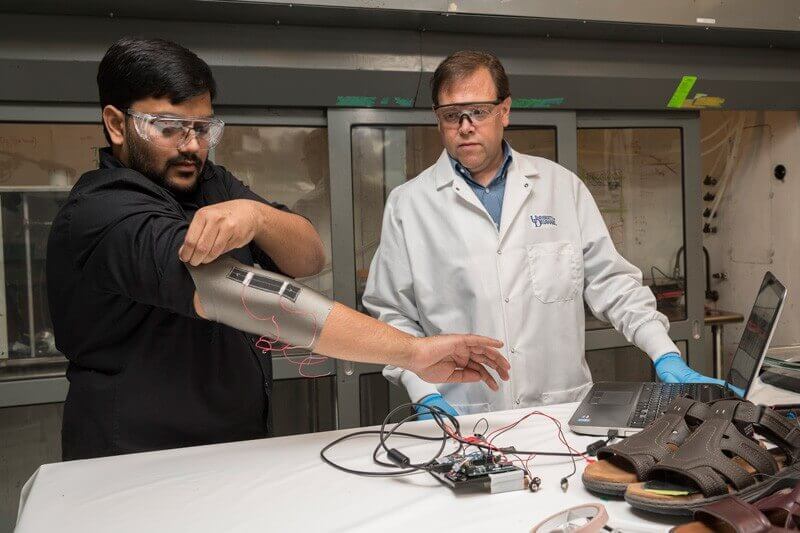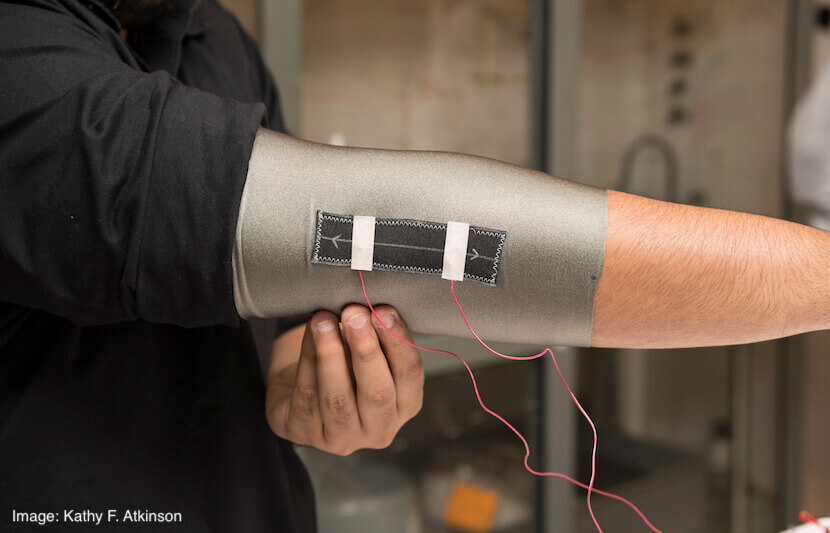Engineers at the University of Delaware have developed a technique to create touch-sensitive smart textiles by coating a variety of fibers, including nylon, cotton and wool, with carbon-based nanomaterials.
The resulting fabrics are equipped with novel sensing abilities that can detect a wide range of pressure — from the light touch of a fingertip to being driven over by a forklift — that could one day be used in clothing or shoes to detect human motion.
“Because the low-cost sensor is thin and flexible the possibility exists to create custom footwear and other garments with integrated electronics to store data during their day-to-day lives,” Sagar Doshi, a doctoral student in mechanical engineering and lead author of the study, said in a statement.
“This data could be analyzed later by researchers or therapists to assess performance and ultimately bring down the cost of healthcare.”
The research is published in the journal ACS Sensors.
Carbon nanotubes
To create the textile coatings, the researchers turned to carbon nanomaterials.
“My lab group has been involved with processing, characterization and modeling of carbon-based nanomaterials over the past several years,” said Erik Thostenson, an associate professor in the Departments of Mechanical Engineering and Materials Science and Engineering.
“We have developed a water-based scalable electrophoretic deposition technique to create nanocomposite fiber coatings. Using this manufacturing technique, we have a unique capability to coat a variety of fabrics such as cotton, nylon, polyester, wool, glass and aramid.”
Carbon nanotubes give the light, flexible and breathable fabric coating its nerve-like sensing abilities. When the material is squeezed, large electrical changes in the fabric are easily measured.
“Through our research, we discovered the unique pressure and strain sensing capability of the coated textile material. The eventual goal is to explore a variety of applications, ranging from smart garments to large scale structures where the technology can be applied,” said Thostenson.
A better method
Using this method, the researchers can add sensors to fabric in a way that’s more comfortable than existing techniques.
Current methods for creating smart textiles, such as plating fibers with metal or knitting fiber and metal strands together, often decrease the comfort and durability of fabrics, explained Thostenson.
But the nanocomposite coating developed by Doshi and Thostenson is flexible and comfortable to touch, and has been tested on a range of natural and synthetic fibers.

Image: Kathy F. Atkinson
Additionally, the coatings are just 250-750 nanometers thick, and would only add about a gram of weight to a typical shoe or garment.
Furthermore, the materials used to make the sensor coating are inexpensive and relatively eco-friendly, Thostenson explained.
“Contrary to popular opinion, the cost of materials used in these novel sensors is not expensive. Carbon nanotubes, the principal active ingredient in these novel sensors are now manufactured on an industrial scale,” said Thostenson.
“Since our manufacturing is done at room temperature and involves an aqueous bath without any harsh chemicals, the processing cost is significantly low.”
Future applications
“One of the most exciting applications for this technology is for analyzing human motion using smart garments,” said Thostenson.
“These smart garments have applications in the healthcare industry for rehabilitation of patients, assessing movement disorders for pediatric population and biomedical devices.”
For example, in one application, the sensor-coated fabric can be used to measure forces on people’s feet as they walk. Such data could help clinicians asses imbalances after injury, or help to prevent injury in athletes.
The researchers are collaborating with Jill Higginson, a professor of mechanical engineering and director of the Neuromuscular Biomechanics Lab at UD, to see how these sensors, when embedded in footwear, compare to biomechanical lab techniques used to capture motion.
“One of our ideas is that we could utilize these novel textiles outside of a laboratory setting — walking down the street, at home, wherever,” Thostenson said in a statement.
In preliminary tests, the researchers found the sensors collect data like a force plate, an expensive lab device that costs thousands of dollars.
What’s next?
Currently, the researchers are collaborating with professors in biomechanics to test the sensors on human subjects, while a professor with expertise in fashion and apparel studies is helping to integrate the sensors in a non-invasive manner.
Additionally, Thostenson explained that research to optimize the sensitivity of the sensors and to scale up the manufacturing process is also being conducted in the lab.
“Since there are numerous potential applications for these sensors, we are looking forward to working with industry as well as other researchers to develop specific applications,” he said.



